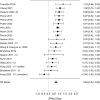A systematic review and meta-analysis of atypical visual attention towards non-social stimuli in preschoolers with autism spectrum disorder
- PMID: 39503176
- PMCID: PMC11638896
- DOI: 10.1002/aur.3261
A systematic review and meta-analysis of atypical visual attention towards non-social stimuli in preschoolers with autism spectrum disorder
Abstract
Research on attention towards non-social stimuli in preschoolers with autism spectrum disorder (ASD) has increased over the past decade; however, findings have been inconsistent. It has been suggested that stimuli relating to common circumscribed interests (CIs) elicit more attention than non-CI related stimuli. This meta-analysis synthesizes results from 31 studies that compared attention towards non-social stimuli in children with ASD under the age of five with typically developing (TD) controls using eye-tracking. Additional subgroup analysis comparing studies that employed non-social stimuli related to CIs frequently reported in adults with ASD to studies using non-CI related stimuli were conducted. Meta-regressions with age, sex, stimulus dimension, nonverbal DQ, and symptom severity were conducted. Results show small (g = 0.39) but significantly higher attention towards non-social stimuli for the ASD group. However, when studies were split based on stimulus type no significant differences for non-CI related stimuli was found. Meanwhile studies employing CI related stimuli reported significant large effects on attention allocation (g = 0.69). None of the conducted regressions reached significance. The findings show increased non-social attention in children with ASD is driven by CI related content rather than a general non-social attentional bias. The findings and future research directions are discussed.
Keywords: ASD; attention; autism; circumscribed interest; eye‐tracking; meta‐analysis; non‐social attention; non‐social stimuli.
© 2024 The Author(s). Autism Research published by International Society for Autism Research and Wiley Periodicals LLC.
Conflict of interest statement
The authors declare no conflicts of interest.
Figures












References
-
- Abdi, H. , & Williams, L. J. (2010). Normalizing data. Encyclopedia of research design. Sage.
-
- Ahmed, Z. A. T. , & Jadhav, M. E. (2020). A review of early detection of autism based on eye‐tracking and sensing technology. In 2020 International Conference on Inventive Computation Technologies (ICICT) (pp. 160–166). IEEE.
-
- American Psychiatric Association . (2013). Diagnostic and statistical manual of mental disorders. American Psychiatric Publishing, a division of American Psychiatric Association.
-
- Attwood, T. (2003). Understanding and managing circumscribed interests. Learning and Behavior Problems in Asperger Syndrome, 126, 147.
Publication types
MeSH terms
Grants and funding
LinkOut - more resources
Full Text Sources
Medical
Miscellaneous

